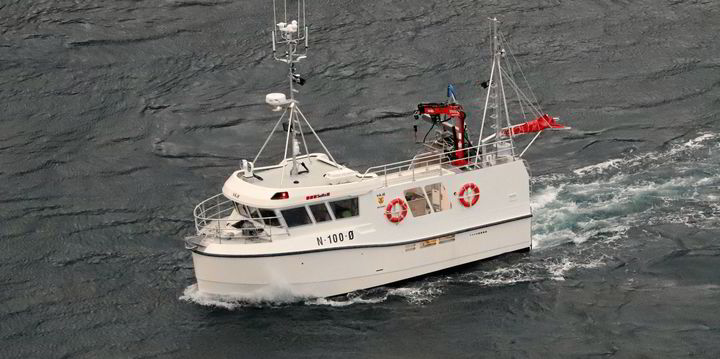If we maintain a stable fleet structure, the development of the stock will highlight overcapacity in the fishing fleet.
At the same time, more and more sustainability goals are entering the fisheries sector, partly driven by public policy and partly by the market. Reimbursement for NOx must be reduced, the Co₂ tax must be increased and the mixing of (expensive) biodiesel must be stepped up.
Green investment is rewarded
It is also new that financial institutions, in collaboration with the Green Shipping Program, are launching differentiated loan and financing schemes to stimulate a green transition for the fishing fleet:
New vessel projects and conversion of existing vessels, which install green propulsion technologies and reduce energy consumption, can achieve better loan and financing terms than fishing vessels that cannot show such conversion.
According to the Directorate of Fisheries’ annual profitability survey, expenditure on fuel is one of the largest expenditure items in fishing. Compared with other vessel and equipment groups, the coastal fleet has a low energy consumption per kg catch.
Dag Standal, senior researcher at SINTEF Ocean. Photo: Private
Fleet renewal
Nevertheless, vessels in the coastal groups are among the oldest vessel groups in the Norwegian fishing fleet. It is an important goal to maintain coastal fishing’s sustainability profile as an environmentally friendly, efficient and attractive workplace that ensures recruitment to the coastal fleet.
The article continues below the ad
There is therefore great potential for fleet renewal, including conversion for the green shift. In order for the fishing fleet to follow wage and cost developments in society and be competitive workplaces and ensure fleet renewal, it is therefore fundamental that the fleet has conditions that correspond to realizing a future-oriented fishing fleet that has the lowest possible environmental impact. Needs more space
When fishermen renew fishing vessels, it is to achieve various efficiency gains, such as increased catch and processing capacity, better technical mobility and sea characteristics as well as good and safe workplaces for the crew.
When the vessels are also to include the installation of green propulsion technologies, such as battery packs and electric motors, the conversion requires more space on board the vessels.
Experience over many years has shown that strict length limits are put under pressure and that the conditions for vessel design change.
Just since the 1970s and 80s, vessel development shows that it is difficult to manage the fleet according to strict length limits, and especially in combination with a chard of various quota rights and structural measures in the coastal groups.
During the last few years, there has nevertheless been a steady tightening of the vessel instructions, which means that the flexible system of authorized lengths has been greatly reduced. In addition, Stortingsmelding (Meld. St. 32, 2018-2019) has decided that the use of authorized lengths shall cease, and that the coastal fleet shall be regulated exclusively according to strict length limits.
Teige Rederi’s “Sunny Lady” is a hybrid boat that uses both LNG gas, batteries and diesel. Photo: Ömer Behar
Obstructive regulation
Many newer coastal vessels have therefore been given a relatively extreme length/width/draft ratio which can break with hydrodynamic principles for vessel design, sea characteristics and when it comes to resistance at sea and energy consumption.
An important question is therefore whether strict length regulations for the coastal fleet under 21 meters meet the needs of a future-oriented coastal fleet. But there are alternative regulatory parameters to strict length limits that can be fully relevant for the coastal fleet.
All other fishing vessels over 21 meters are regulated according to hold volume. This gives coastal fishermen greater flexibility to design their own vessels more specifically according to their own operating and fishing grounds, including the installation of green technologies to meet the authorities’ environmental requirements.
Volume displacement (the sum of light ship weight and dead weight) can also be considered as an alternative regulatory parameter to fixed length limits. Displacement also has a clear definition and rule interpretation (cf. fixed lengths), but gives worse conditions/incentives for taking heavy battery packs etc. on board.
Must be flexible
In relation to the goals for a future-oriented coastal fleet that combines optimal sea characteristics and environmentally friendly technologies, regulation according to hold volume can therefore provide the best conditions for future coastal vessels. But as cargo space volume gives greater freedom to vessel design, it can contribute to changes in the structural composition of the coastal fleet. Other effects may be increased capital tying up and structuring and that local value chains are affected.
Alternatively, a flexible legal length system will be continued, which will clearly reduce the pressure on rigid length limits over time.
We can therefore hope that quota notification 2.0, when it is presented on 12 January 2024, contains a thorough assessment of what could be good and environmentally sound framework conditions for a future-oriented coastal fleet.
2023-12-17 17:39:18
#Strict #length #limits #put #forwardlooking #fishing #boats

